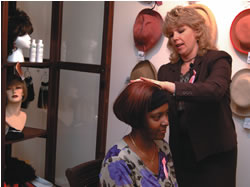To the biodefense
Gunning for security systems
No more cracked chests?
Voices off turned on
Milestones
Reading, writing, and good health
New 'do' for cancer patients
More big bucks for research




To the biodefense
It's almost enough to make you want to wear your face mask around the clock, wash your hands obsessively, maybe even duck and cover. In the past year, this country has seen natural outbreaks of SARS, West Nile virus, and monkeypox. To that worrisome mix, add potential bioterrorist agents such as smallpox, plague, and anthrax, plus naturally occurring emerging infections that frequently jump from animals to man.
Infectious diseases - both naturally occurring or human biothreats - are top priorities for federal funding these days. And the Woodruff Health Sciences Center (WHSC) has been on the receiving end, with recent grant awards for almost $30 million for biodefense research over the next five years. Emory is well positioned to be among the leaders of such research, with our Emory Vaccine Research Center, strong research collaborations with the CDC, and basic and clinical scientists who have been at the forefront of the global battle against emerging infectious diseases for decades.
The School of Medicine received a grant of $16 million to lead one of five national Cooperative Centers for Translational Research on Human Immunology and Biodefense. The 4.5-year grant is part of $85 million in NIAID (National Institute of Allergy and Infectious Diseases) awards aimed at better understanding human immune response to potential agents of bioterror and rapid development of countermeasures such as vaccines and therapies. The translational centers will focus on moving new findings about immune system function out of the laboratory and into clinical trials.
The Emory-led projects will include studying the human immune response to a vaccine in its entirety -- from innate responses to peak immune responses to the development of long-term immune memory. Scientists also will seek to understand at a cellular level how vaccines lose their effectiveness over time and then will try to improve the responses of the elderly to vaccination, says Rafi Ahmed, director of the vaccine center and the grant's principal investigator.
Other institutions in the Emory center include the Institute for Systems Biology in Seattle; the Institute for Research in Biomedicine in Bellinzona, Switzerland; the Mayo Clinic; and the CDC.
Emory is also part of a six-university consortium leading a new biodefense initiative to develop the next generation of vaccines, drugs, and diagnostic tests against emerging infections. Scientists in the WHSC will receive about $12 million as part of a $45 million NIAID grant for a Southeastern Regional Center of Excellence for Emerging Infections and Biodefense (SERCEB), led by Duke University. Researchers from Emory, Duke, University of Alabama at Birmingham, University of Florida, University of North Carolina at Chapel Hill, and Vanderbilt will initially focusing on orthopoxviruses (including smallpox and monkeypox), anthrax, and Yersinia pestis, the bacteria that causes plague.
The consortium is one of eight created by NIAID to do basic and applied research, train researchers and other personnel for emerging infection and biodefense research activities and develop and maintain comprehensive core facilities to support research and training activities. SERCEB funding will support the work of scientists in the schools of medicine and public health, Yerkes, and the vaccine center, as well as collaborations with the CDC.
Emory will take the lead in a career development project to train scientists throughout the region in high-containment microbial science and biosafety, says David Stephens, who will co-lead the consortium. In all, there are more than a half dozen SERCEB projects under way already at Emory.
For more information about these and other grants, visit www.emory.edu/WHSC/HSNEWS/releases/.

Gunning for security systems
Dendritic cells - the security cameras of the immune system - monitor whether foreign substances in the body present a danger to the rest of the immune system. With a gene gun that shoots microscopic gold pellets with DNA into the skin, scientists have developed a sensitive method to detect and follow dendritic cells by marking them with a change in their DNA. And they've discovered that dendritic cells are more numerous and longer lived than previously thought. Their research could lead to a faster and simpler way to vaccinate against emerging diseases like West Nile virus, SARS, or hepatitis C.
With their finger-like projections, dendritic cells continually capture external proteins and digest them into fragments. T-cells (the police who watch the cameras) examine the fragments on dendritic cell surfaces and sound the alarm to the rest of the immune system if they determine that those fragments are dangerous.
Dendritic cells migrate between the skin and the lymph nodes, where T cells and other white cells congregate, according to Joshy Jacob, assistant professor of microbiology and immunology. In their paper in the journal of Nature Immunology in September, he and postdoctoral fellow Sanjay Garg suggest that the DNA provides just enough of a signal to induce the dendritic cells, which are activated by inflammation or physical trauma, to migrate to the lymph nodes.
The gene gun could present an attractive alternative to conventional ways of making vaccines, Jacob says. "Usually you have to figure out how to grow a virus, then inactivate it so that it doesn't cause an infection. This new methodology could take advantage of the immunizing capabilities of abundant, long-lived dendritic cells."



No more cracked chests?
To repair a blocked coronary artery, would you prefer that a surgeon break your sternum or make a small incision?
The choice was clear to Harold Goldberg, a Syracuse, NY, attorney who traveled to Emory recently for endoscopic atraumatic coronary artery bypass (endo-ACAB) surgery -- a minimally invasive technique developed by cardiothoracic surgeon Thomas Vassiliades. Nationally known for developing robotics-assisted techniques, he uses small incisions between the ribs rather than the traditional open chest approach that requires a large incision through the sternum.
The advantages of endo-ACAB surgery are many. It's performed off-pump (heart-lung machines are usually the culprit in morbidity), and there's no painful chest incision and accompanying concerns about the wound healing. Goldberg, like most patients who undergo endo-ACAB, was able to leave the hospital within 48 hours and return to full activity. CABG surgery requires up to three months for recovery.


Voices off turned on
From baritones to broadcasters, salespeople to schoolteachers, millions depend on the normal functioning of their voices to win friends, influence people, and bring home the bacon. Yet scores of factors - ranging from poor vocal technique to diseases of the mouth and throat - can threaten our ability to speak or sing with confidence and authority.
The new Voice Center at Emory Crawford Long Hospital is equipped to diagnose, treat, and rehabilitate those with voice disorders who make their living by using their voice, says voice and throat specialist Michael Johns III.
Besides voice disorders such as voice misuse and overuse, patients will be treated for ailments such as laryngopharyngeal reflux, laryngeal tumors, spasmodic dysphonia, vocal cord paralysis, vocal fold scarring, vocal fold nodules and polyps, and vocal fold bowing.
The center also plans to develop its own preventive health program for the speaking voice. A clinical and basic science research component in collaboration with labs at Emory and Georgia Tech will also be an integral part of the program.
For more information call Emory Health Connection at 404/778-7777 or 1-800/75-EMORY.


Milestones
The Winship Cancer Institute took a giant step closer to becoming a comprehensive cancer center. The National Cancer Institute awarded Emory a $1.9 million P-20 grant to establish research programs required for that eventual designation. (See From the CEO)
It now only takes a painless, noninvasive minute or two to produce a three-dimensional picture of a beating heart that a physician can view from any angle -- almost as if he were holding the patient's heart in his hands. The new Live 3D Echo at The Emory Clinic at Emory Crawford Long Hospital is the first in Georgia to offer 3D ultrasound images of the heart and help doctors make better diagnostic decisions.
(See www.emory.edu/WHSC/HSNEWS/releases/july03/echocard.html)
Sponsored research is still on a fast-forward trajectory in the Woodruff Health Sciences Center (WHSC), which in FY2003 accounted for more than 92% of total university research dollars ($319.1 million). Here's how the WHSC's $295.5 million (a 16% increase over previous fiscal year) breaks down:
- $204 million (17% increase) for the School of Medicine (SOM)
- $45.1 million (24% increase) for the Rollins School of Public Health (RSPH)
- $3.3 million (26% increase) for the Nell Hodgson Woodruff School of Nursing
- $43 million (5% increase) for the Yerkes National Primate Research Center
All of the university's top 10 departments in funded research reside in the WHSC:
- Medicine (SOM)
- Neurology (SOM)
- Psychiatry (SOM)
- Behavioral sciences and health education (RSPH)
- Pathology and laboratory medicine (SOM)
- Surgery (SOM)
- Pediatrics (SOM)
- Epidemiology (RSPH)
- Administration (Yerkes)
- Microbiology and immunology (Yerkes)
Monkeys sense inequity
Life isn't fair. Humans know it, and according to new research, monkeys do too. Researchers at the Yerkes National Primate Research Center have confirmed that nonhuman primates do indeed have a sense of fairness. In the September 18 issue of Nature, graduate student Sarah Brosnan and psychologist Frans de Waal, both of the Yerkes Primate Research Center and Living Links Center, explain how they made food-related exchanges with brown capuchin monkeys, who would reject previously acceptable rewards (cucumbers) if they witnessed other monkeys receiving more desired rewards (grapes) for equal or less work.
Brosnan and de Waal led the team of researchers who made connections between their findings and similar findings in humans. "People often forgo an available reward because it is not what they expect or think is fair," says Brosnan. "Such irrational behavior has baffled scientists and economists, who traditionally have argued all economic decisions are rational. Our findings in nonhuman primates indicate that the emotional sense of fairness plays a key role in such decision-making." Identifying reactions in nonhuman primates similar to those of humans offers insight into how such emotional responses developed. Brosnan's and de Waal's experiment suggests that the irrational human tendency to ignore marginal benefit for lack of equity is a trait that has existed for thousands of years.

An emotional sense of fairness plays a key role in some decision-making both in primates and
in humans.

Reading, writing, and good health
When the 2-year-old was diagnosed with an ear infection, her mother was instructed to administer her daughter's medication twice a day. After reading the label on the bottle, her mother filled a teaspoon and poured the medication into her daughter's ear.
Grady internist Ruth Parker points to this true story as a glaring example of the devastating impact of poor health literacy on Americans. About one out of every three adults in America has problems with health literacy. The effect? A 1998 analysis by the National Academy on an Aging Society estimated that low health literacy may cost the health care system as much as $73 billion annually. Health literacy is a major factor in quality of care, cost containment, safety, and patients' involvement in health care decisions, she adds.
Parker served on the Institute of Medicine's Committee on Health Literacy in 2002 to study problems related to poor health literacy. "As physicians, we spend a great deal of time in both learning and creating information, through medical science and research. Yet we don't spend enough time checking to see whether people understand the information we convey to them in clinic visits and other patient encounters. As a physician, if you don't check to see what people understand, you don't know how they're going to act on it. That's why health literacy is directly related to quality of care. Lack of health literacy is a source of medical errors."
As health care becomes more technologically sophisticated, patients with low literacy aren't able to function as informed consumers and are the ones most likely to be left behind. The elderly are particularly vulnerable. Parker says that technological progress in health care will deepen disparities over time, especially for sicker, older, and more vulnerable groups. The study's focus on the elderly is intentional, says Parker, because many are chronically ill and take various medications, and the choices Medicare beneficiaries face have become increasingly complex.
"Health literacy is a common problem, but we don't want to blame the victim," she says. "Health care is an incredibly complicated system these days. As doctors, we need to help patients feel more empowered to say they don't understand when they don't, and we need to make sure the people who work in medical systems like our own realize how many people struggle to understand what they need to do to take care of themselves."


New 'do' for cancer patients
Business school administrative assistant Shawana Sanders tries on a wig at Renewal, a specialty boutique in the Winship Cancer Center. After chemotherapy every 21 days since June, Sanders lost her hair but is encouraged by a promising prognosis for her breast cancer. Renewal owner Carla Grover, a former nurse and cancer survivor herself, stocks items in the shop ranging from scarves to prosthetics.


In this issue
From the CEO / LettersHow Nellie got her groove back
Trapping the mutant virus
Doing a 360 in the WLA
Moving forward
Noteworthy
On Point:
Not the same old, same old

More big bucks for research
Major funding for medical research continues to hit record levels in some areas. A sampling:
- Emory scientists led by Microbiology and Immunology Chair Richard Compans are partners in two new HIV vaccine research teams funded by grants totalling $35 million from the National Institute of Allergy and Infectious Diseases. The teams - one led by the University of Alabama, Birmingham, and the other by Novavax - are developing vaccines using virus-like particles (VLPs), which closely resemble the HIV virus but are devoid of the infectious viral genes. Compans and his Emory colleagues already have constructed VLPs that induce both antibody and cellular immune responses in mice and monkeys.
- Researchers in medicine, physiology, and pediatrics received $7 million from the NIH to combat acute respiratory distress syndrome and its association with chronic alcohol abuse.
- A multidisciplinary group of investigators will study the biology of digestive diseases in a new Digestive Diseases Research Development Center funded by a five-year, $2.6 million grant from the NIH.
Copyright © Emory University, 2003. All Rights Reserved.
Send comments to the Editors.
Web version by Jaime Henriquez.